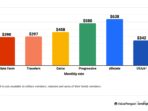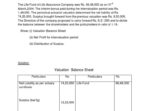How Big Is The Insurance Industry In The Us – Genre (liability, commercial engine insurance, commercial property insurance, maritime insurance and others), industry size (large companies, small and medium -sized companies), distribution channels (representatives and brokers and brokers, direct response and other), industrial vertical (transport and logistics, production, construction, construction, construction, construction, construction, construction, construction, construction, construction
Market Review: The US Commercial Insurance Market size was $ 294.6 billion in 2024. Demand for customized insurance solutions includes key factors that increase market growth.
How Big Is The Insurance Industry In The Us

Commercial insurance demonstrates a range of insurance designed to protect companies and organizations from financial losses due to a variety of risks and debts. It includes property damage, liability rights, employee risks, business interruptions and much more. Commercial insurance provides companies with a security network by providing relief for unexpected events, which can lead to significant financial burdens. Depending on the special industry and the size of the company, it protects against natural risks, ensuring continuity, economic security and peace of mind for business owners and mediators.
U.s. Burial Insurance Market Size, Trends, Share, Growth
Continuing stores in various industries in the United States has increased the need for comprehensive insurance protection, which mainly increases the growth of the commercial insurance market. In addition, as a large number of companies to diversify their operations and engage in global trade, exposure to risks such as property damage, liability rights and barriers to supply chain will increase the demand for special insurance solutions. In addition, the increase in cyber threats and information violations has increased the need for security insurance in a growing digital trading environment that strengthens market growth. In addition, regulatory changes and conformity requirements in sectors, such as health care, financing and production, are strong companies to obtain similar insurance, thus promoting market growth. In addition, the preliminary approach to risk management is the highest, and companies are important to accept insurance products that provide financial security against unexpected events responsible for market expansion.
Commercial insurance markets are significantly influenced by the rules of industry as a whole. As the regulatory frames become harder, companies are forced to obtain comprehensive insurance protection to meet the requirements of conformity. In addition, industrial sectors, such as health care, financing and production, are subject to specific regulatory regulations that require certain types of insurance protection. For example, the sickness sector requires medical insurance to reduce the risks of liability, but financial institutions need a number of professional responsibilities to combat errors and neglect. These regulatory transfers require companies to introduce large -scale risk management strategies to ensure that demand for certain insurance products, but also to ensure compliance with legal programs.
As the complexity of the business and the correlation between global supply chains increases, more preliminary risk management is emphasized. Companies recognize the importance of possible risks to ensure continuity and to protect the funds. Trade insurance plays an important role in this process by providing corresponding scope options to correct certain errors. For example, companies working in natural disasters can choose property insurance to protect against physical damage. In addition, the rise of cyber threats has obtained demand for information network insurance to protect information violations and other risks associated with the network. Increasing concentration on risk management will help events to get comprehensive insurance solutions that match their risk profiles and reduce any financial responsibilities.
The IMARC Group provides an analysis of the US Commercial Insurance Market Report on each part of each part and forecasts at the country level in 2025-2033. According to our report, the Enterprise size, the distribution channel has classified the market vertically based on industry.
Largest Auto Insurance Companies In The U.s. (2024)
The report provided a detailed fragment and market analysis based on the genre. It includes liability insurance, commercial engine insurance, commercial property insurance, ocean insurance and others. According to the report, commercial property insurance represents most.
Continuing events as real estate values rise has increased the need for visual insurance protection in order to protect against potential risks and losses. Accordingly, the growing frequency and intensity of natural disasters, such as hurricanes, forest fires and currents, emphasize the importance of comprehensive insurance solutions for commercial properties, leading to market growth. In addition, more emphasis on developing regulatory landscape and industrial management has led to an increase in commercial property insurance as companies are trying to reduce potential financial debts caused by property -related events.
The report is also in the report, detailed fragmentation and market analysis based on industry size. It includes large companies and small and medium -sized businesses. According to the report, big companies have the largest market share.

The increasing demand for commercial insurance in large companies performs different factors that meet their complex operational requirements. In addition, more comprehensive insurance protection is needed, which improves the complexity of business and exposure to the risk of expanding global footprints of large companies. In addition, the increase in cyber threats and information violations has increased the importance of information network insurance to maintain sensitive information and ensure business continuity by deferring market demand. In addition, the complex networks of the large companies and the interdependence of the supply chain have emphasized the need for special extent alternatives, such as commerce interruption insurance, to resolve potential obstacles and financial losses.
Us D&o Premium Growth Drives Loss Ratio Improvement: Fitch
The report provided a detailed fragment and market analysis based on the delivery channel. It contains representatives and brokers, a direct answer and others. According to the report, the direct answer represents most.
Change in customer preferences and the progress of technology represents one of the key factors that arouse the direct answer to the demand for commercial insurance. With the growing comfort and access of digital platforms, companies are looking for more streamlined and efficient ways to buy insurance directly by passing traditional brokers. This trend is compatible with the emphasis on tailor -made insurance solutions, as direct response models allow for corresponding scope options that meet the individual needs of the events. In addition, transparency and rapid reaction time provided by digital communications resonate with a new generation of business owners, leading to the popularity of commercial insurance.
The detailed market fragment and analysis of the market is also presented in the report based on industrial vertical. It includes transportation and logistics, production, construction, IT and telecommunications, health care, fuel and utilities, and others. According to the report, transportation and logistics have the highest market share.
The demand for commercial insurance in the field of transport and logistics is postponed by a combination of industrial-specific challenges and developing regulatory landscape. When the industry is based on the frequency of obstacles, accidents and freight damage, the need for comprehensive insurance is the highest market growth. In addition, strict rules on regulating safety standards, responsibility and goods management practices require similar insurance solutions to meet these unique requirements, which promotes market growth. In addition, aggravation of electronic trade continues to increase demand as companies require the scope to reduce the risks associated with the distribution and storage management of the last mile, which defer market growth.
23 Eye-opening Cybersecurity Insurance Statistics
The Market Research Report also provided a comprehensive analysis of all major regional markets, including northeastern, midwest, southern and West.
The US Commercial Insurance Market offers a dynamic and competitive landscape that is characterized by a diverse selection of competing insurance suppliers from market share. This ecosystem is dominated by well -established insurance giant, each with a comprehensive scope of capital, in accordance with the various industries and business sizes. These key players retain their importance in many resources, visual arguments, field qualities and extensive distribution networks. In addition, the growth of insertec startup companies has introduced innovative digital platforms to facilitate the procurement process and more personal personal solutions for companies. This arrival of technology -driven competition has forced traditional insurers to increase their digital stakes, which redefines competitive kinetics on the market.
The Market Research Report has provided a comprehensive analysis of the market landscape. The detailed profiles of all large companies are also provided.

Via PDF and Excel email (we can give the report to be edited with a special request in PPT/Word Format)
U.s. Property-casualty Insurance Trends And Outlook For 2022
Consumers’ awareness of many commercial benefits, such as business safety, business reputation, protecting employee well -being and employee financial situation, mainly in the management of the US commercial insurance markets.
The sudden burst of Kovid -19 infection has led to increased commercial insurance from different organizations to reduce the loss of corona vanfection.
According to the genre, the United States is divided into commercial insurance markets as liability insurance, commercial engine insurance, commercial property insurance, ocean insurance and others. Of these, commercial property insurance currently demonstrates a clear dominant position













